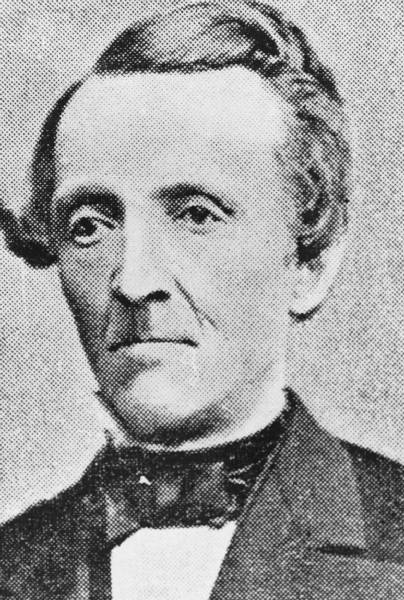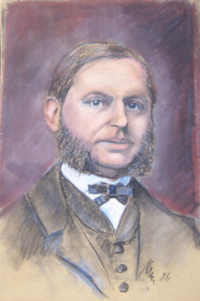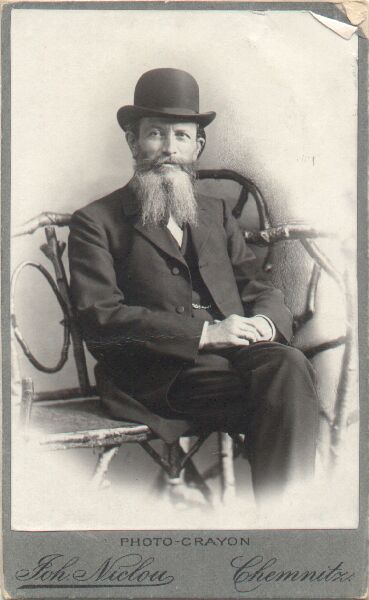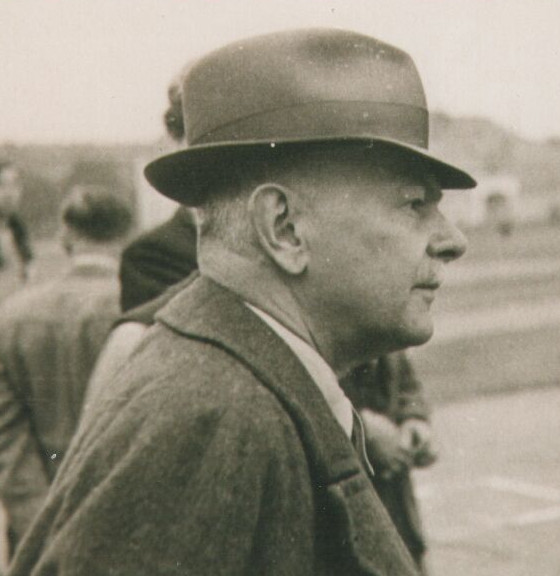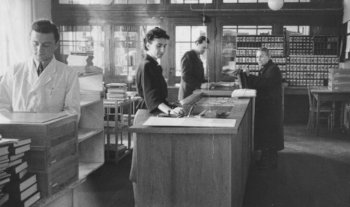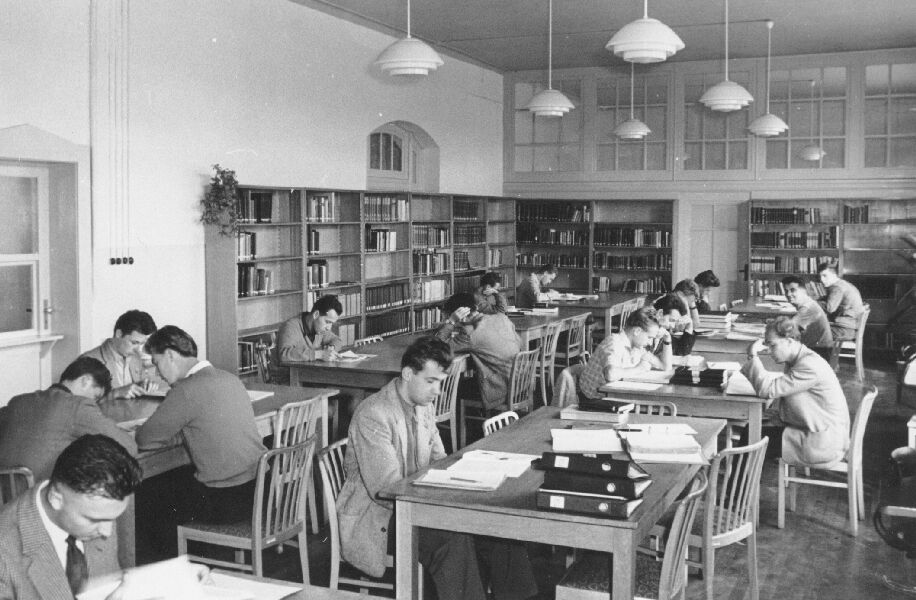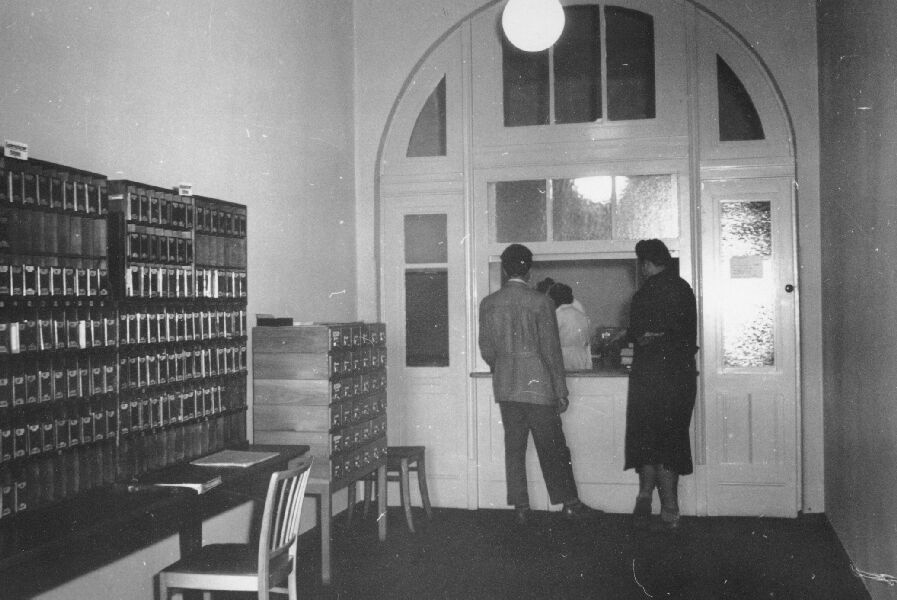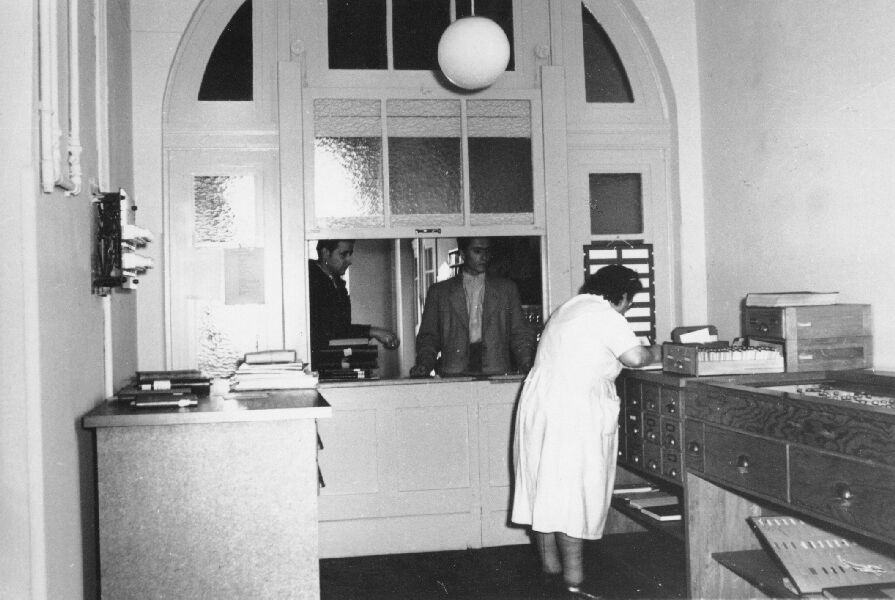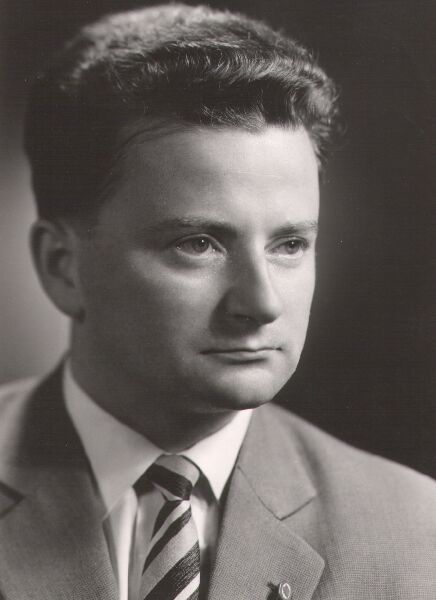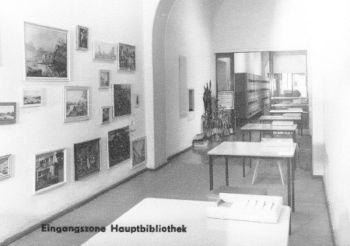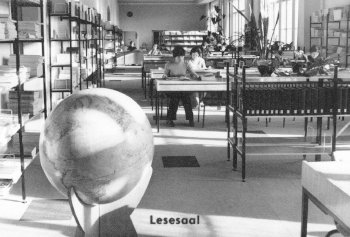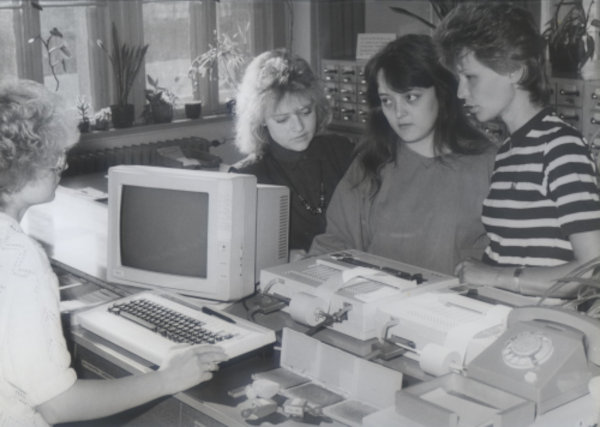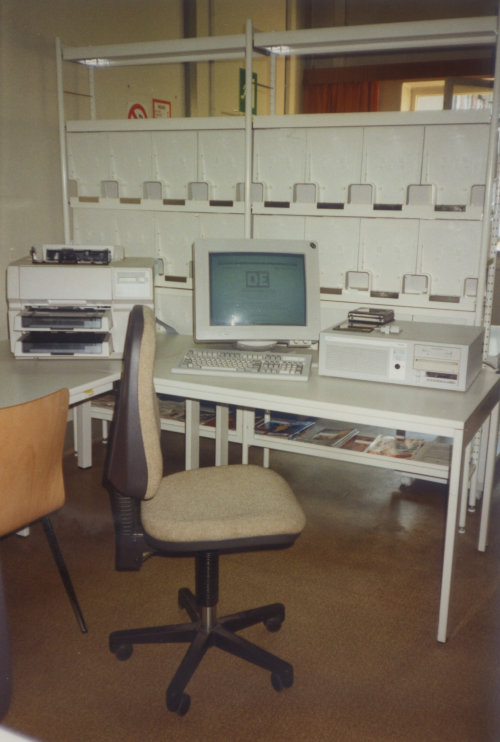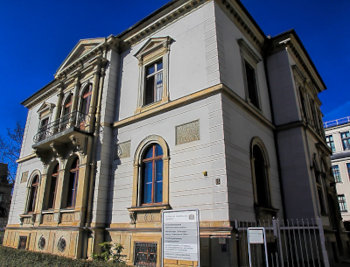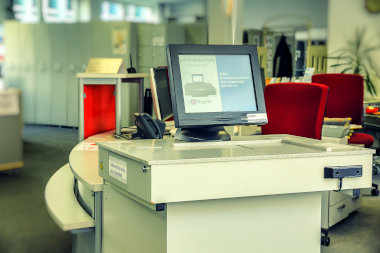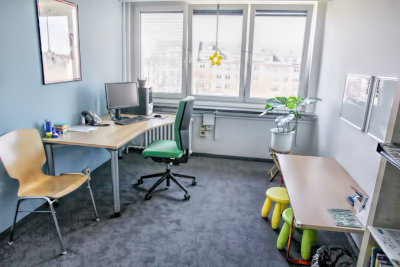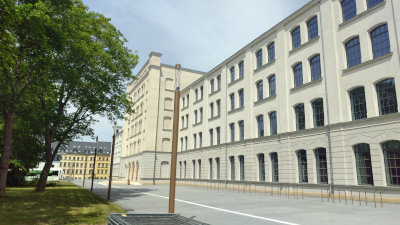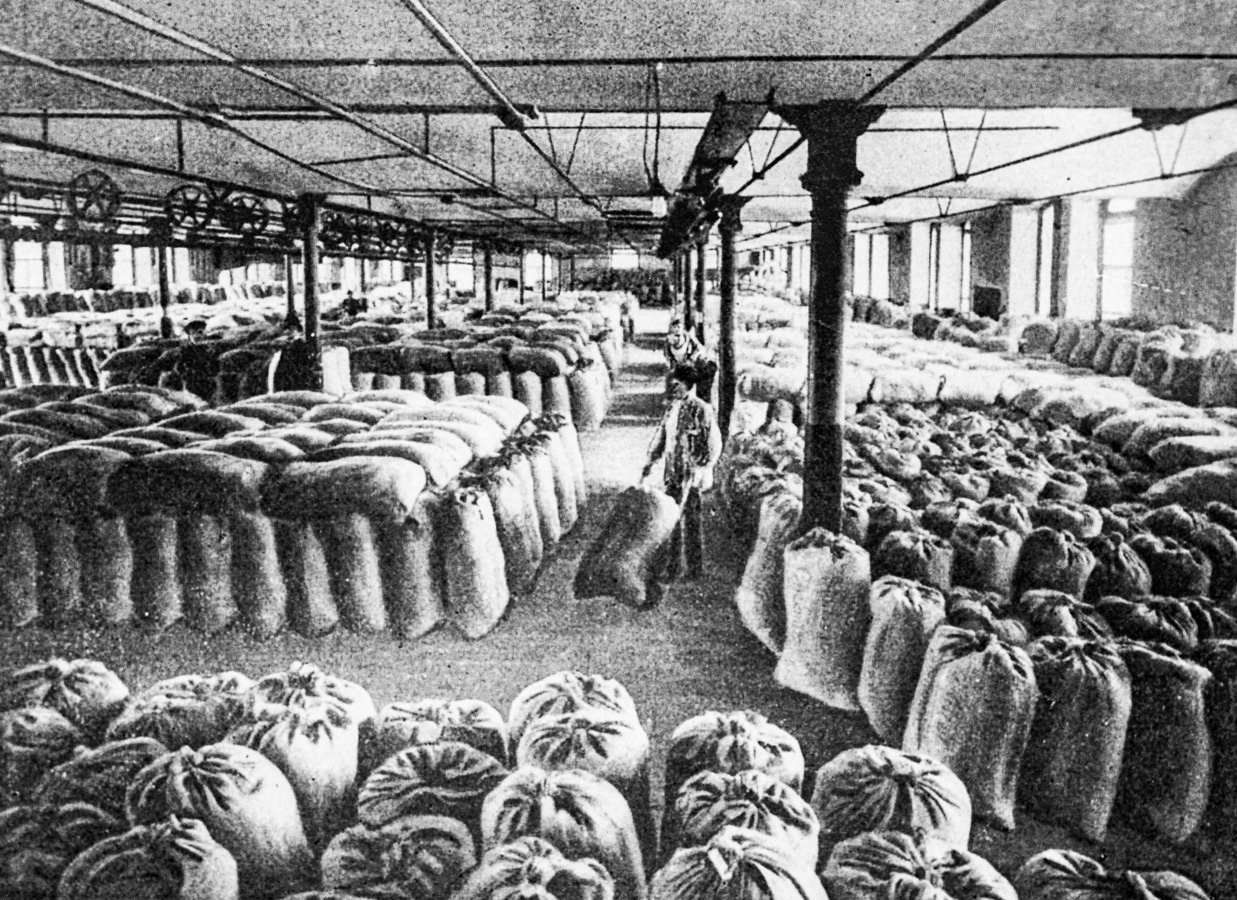Search

Contact & About us
History
History of the Library: Brief overview of facts & figures
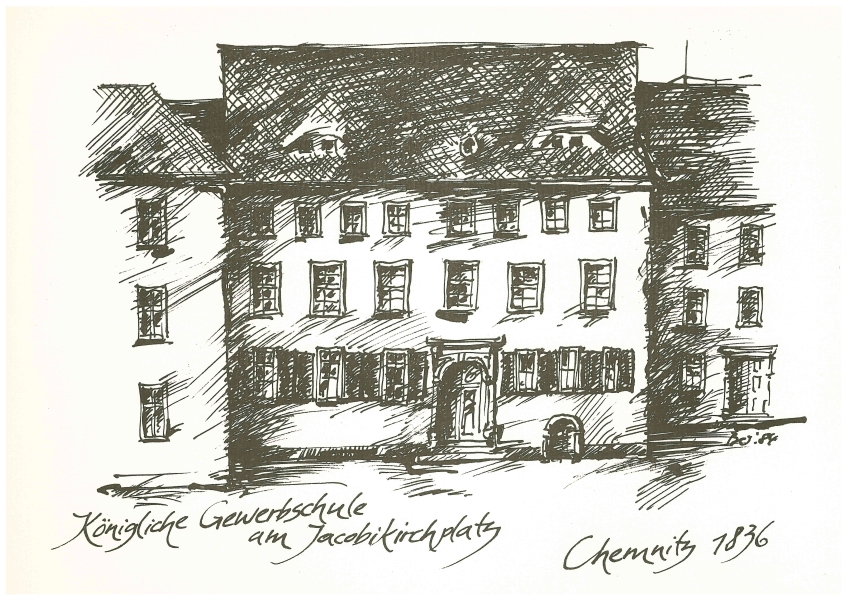
In 1836, the Library was founded. It derived from a merger of the separate libraries of the Industrial School, of the School of Civil Engineering and of the Craftsmen School.
In 1848 the Library was for the first time allocated in an own room in the new school building at Dresdner Straße.
In 1861 the Library celebrated its 25-year-anniversary. The collections included 5150 volumes, 1121 brochures and 154 panels. The collections were recorded in two written registers – one register of authors in alphabetical order and one subject index classified according to 11 subject groups.
The Library was headed by Prof. Schnedermann, the director of the 3 merged schools; a clerk was responsible for the library work.
In 1862, the collection of books raised to a number of 20 000 volumes.
From 1864 until 1874 with an interception from 1867 – 1870, Prof. Böttcher headed the Library.
In 1867, the current workload made it necessary to employ a library warden (head of the library).
The teacher Junghänel took over this job until 1870.
In 1874, the first Library officer was employed: Prof. Judenfeind-Hülße took over this office until 1903.
In 1877/78, the Library moved to rooms at the ground floor of the newly constructed school building at Schillerplatz.
The first printed book index was released.
The Library became information point for patent documents of the German Patent Office for Chemnitz and surroundings.
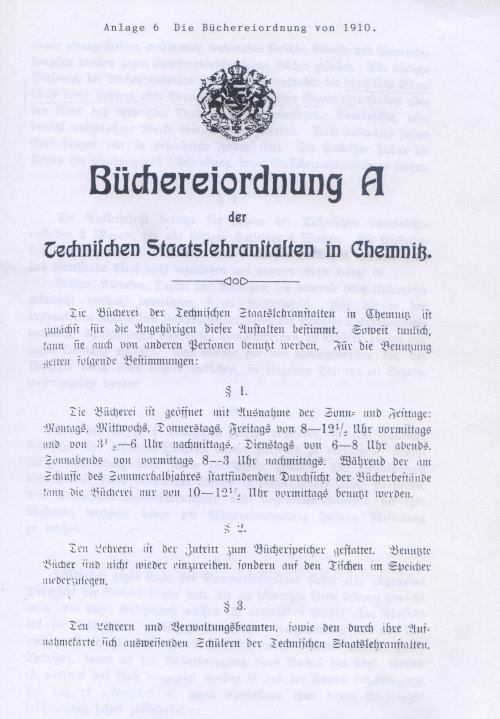
In 1878, the administration of the Library was centralized.
In 1886, the Library celebrated its 50-years-anniversary. Its collections comprised 19 164 volumes (incl. atlases and brochures), 308 maps, 3600 patent documents.
In 1896, the readings spaces were expanded.
In 1906, the Library moved to an extension building of the State Technical School at Albertstraße where it made use of the 2nd to the 4th level. The reading hall offered 36 seats, 150 volumes of reference works and 160 journals.
In 1910, the Library got printed library regulations regulating the entire official operations of the Library. Its collections raised up to 39 776 volumes (including 2591 atlases and brochures), 830 maps, 222 281 patent documents.
From 1926 until 1945, the Library was headed by Prof. Mentzel.
In 1936, the collections included ca. 65 000 books and 624 000 patent documents. Apart from completely mechanical, chemical and textile engineering-orientated books, the Library also acquired literature on the fields of political science, economics, economic geography, aviation and military as well as civil engineering, road construction and surveying.
In 1948, the evacuated historic collections were integrated in the City Library as the Library was destroyed. The entire collections were purged from fascist literature. 42 873 volumes, 17 554 brochures, 3 660 image panels, maps and atlases as well as 749 122 patent documents remained.
In 1950, the patent documents were transferred to the newly-established patent office at Berlin.
In 1953, the collections from the ancient Library were outsourced from the City Library and the Library was re-allocated to the School.
In 1954, the Library was admitted to interlibrary loan.
In 1955, the University Library was enhanced and the first qualified librarian, Mr. Dieter Scheffel, took up office (in the past mostly librarian as sideline activity).
From 1958 to 1962, the number of reading places raised up to 72, a book elevator was installed and the Library was enlarged by 3 stacks levels. The number of its staff members raised up to 22.
The establishment of the Department for Patent documents and Gazettes of standards was initiated which collected all patents in the GDR and FRG from 1945 on.
In 1960, the elaboration of a central catalog for the district Karl-Marx-Stadt on the fields of engineering and natural sciences was initiated. In 1962, 200 institutions collaborated within works on the catalog.
In 1961, the establishment of the Department Technical-Scientific Information Center started which later developed to the Information Reading Hall.
Until this year, Prof. Dr. Klitzsch assumed the head of library office.
In 1962, the Library owned 150 657 titles.
In 1963, Dr. phil. Scheffel was appointed as Director of the Library. Since 1961, he had assumed this office provisionally.
In 1969, resulting from the 3rd Higher Education Reform, the separate libraries of the institutes and their staff members were allocated to the Director of the University Library (previously, the collections, at most individual collections, were allocated to the institutes)
In 1970, it was envisaged to merge the minor branch libraries to major departmental libraries. This was the beginning of the establishment of a decentralized University Library.
Another decision regarded the closing of the Patent Information Point.
In 1973, the minor branch libraries merged to 13 sectional libraries providing literature of related and neighboring scientific fields. For differentiation, they were assigned an “S” accompanied by a combination of numbers.
In 1974, parts of the literature were for the first time set up in the way of an open-stack system according to concordance (division into three: course book collection, open stacks and closed stacks collection). A collection of gazettes of standards was established (GDR-standards, DIN-standards etc.)
In 1980, the Polytechnic Patent Library (PPL) was established within the implementation of an act of the Ministerial Council.
In 1983, the Library was accorded the status of a Central Subject-specific Library for Mechanical Engineering of the GDR
In 1985, the PPL moves from the Central Library (Information Reading Hall) in the auxiliary building of the Institute for Vocational Higher Education, Annaberger Str.
1988 The first computer and the first matrix printer were put into service.
The first application was implemented at the journal division by a self-made journal administration program based on a relational database system.
A structurally-identical computer did not comply with the requirements of the lending desk so that it was substituted by a computer P8000 in 1989 as this computer was equipped with a hard disk and a multi-user operating system allowing to manage several terminals at the same time.
In 1990 the Library was striving for getting back the outsourced patent collections.
The Library of the Institute for Teacher Training Rochlitz was allocated to the collections of the Library but still remained independent.
New opportunities for searching in CD-ROM databases and first online searches were offered.
In 1993 Dr. Hermes assumed the office as Head of the Library.
1200 units from the collections of the Library at Rochlitz were transferred to Chemnitz.
The Library integrated literature from the VEB Fettchemie and the Fritz-Heckert-Kombinat Chemnitz. Extensive eliminations of multiple copies were carried out. The Polytechnic Patent Library was turned into a Patent Information Center.
The card catalog was stopped and replaced by a cataloguing within a southwest network and search in an OPAC. At the same time, the Regensburg Common Library Classification System was introduced.
In 1994 the sectional libraries were merged to 4 partial libraries (economics/ humanities, electrical engineering/ physics, mechanical engineering and site at Zwickau). The branch and research libraries remained unaffected.
In 1996, a commercial electronic lending system was introduced at all parts.
The outsourced patent documents could be re-transferred to Chemnitz.
The partial libraries electrical engineering/ physics and mechanical engineering moved together into the Weinhold-building and became the partial library for natural sciences and engineering.
In 1997 the partial library humanities and mathematics moved into the Pegasus-Center. At the same time, the media collections from the partial library at Zwickau were integrated in this location.
In 1998 also the Subject Information Center moved into the Pegasus Center.
In the summer, the www-interlibrary loan was activated for staff members and students of the University.
The Patent Information Center moved into the International Meeting and Information Center of Chemnitz University of Technology, Bahnhofstraße 8.
In 2000, the research library computer science was integrated in the Main Library.
In November 2022, the management of the Library changed: Ms. Thümer was appointed as acting Head of the Library as Dr. Hermes was engaged by the University Management for the elaboration of the history of the university for a period of 3 years.
In 2001 the Patent Information Center became the official submission point for applications for property rights of the German Patent and Trademark Office.
The University Computer Center took over the responsibility for the development of the IT-infrastructure of the University Library. A concept was elaborated which was implemented by funding of the German Research Foundation. The public areas were equipped with high-performance computer workstations, each provided with internet access and offering the opportunity to digitally process search results.
The database access system CHARLI (Chemnitz Database Infoserver Online) could be provided.
All CD-ROM- and Online-Databases were offered via a consistent www-interface.
2003 A new organizational structure implemented: the departments for cataloguing and acquisition were combined to the unit media processing; the public area of the Main Library and the 3 partial libraries were merged to the unit Service.
The new integrated and Saxony-wide applied library system LIBERO was put into operation in March 2003.
In August 2003, the development of a subject-specific library within the European Union-funded Saxon-Czech University Center was started.
In the course of the year, the research library chemistry was integrated in the Main Library.
The Saxon Act on Library Charges was implemented. In addition, the Library Regulations, the Library Usage Regulations and the Regulations on the Usage of the Public Computer Workstations of the University Library were reviewed.
2005 The project information skills was initiated with the objective to teach the key competence information skills integrated in the Bachelor- and Master degree programs of Chemnitz University of Technology.
The virtual information system Question Point was introduced in order to provide the opportunity to users to ask their questions to library staff members independently from opening hours.
The submission and processing of interlibrary loan orders was done in online operation allowing to significantly streamline the processing times.
For the first time, the Library offers Electronic Course Reserve Collections.
In 2006 Angela Malz took up the office as Head of the Library.
2007 Integration of the course Teaching of Information Skills in the Bachelor studies within the degree programs German Studies, Technical Communication, Political Science, English Studies and Economics.
The first self-checkout station was put into operation at the Campus Library I.
In 2008 the University Management of Chemnitz University of Technology decides to establish the University Press as unit of the Library. By the foundation adherents of Chemnitz University of Technology shall be provided with an attractive opportunity to publish in a cost-efficient way under the trademark of Chemnitz University of Technology. It is the only university in Saxony offering an own university press.
In addition, the University Bibliography is being established.
2009 The Regulations on the Usage of the Library are translated in English.
The University Library introduces the Open Source Ticket Request System (OTRS). All services could be reached by one single email-address.
Within the Saxon-Czech University Initiative, additional funding resources are provided for the enhancement of the Saxon-Czech Subject-specific Library until 2012.
The course Teaching of Information Skills is offered as blended learning version. OPAL serves as learning platform.
The partial libraries Economics and Legal Sciences, Natural Sciences and Engineering and the collection Mathematics are being merged to the Campus Library II. Thus, the number of Library sites is being reduced to 3 (Main Library, Campus Library I and Campus Library II) and the Patent Information Center.
2010 A Saxony-wide full text-repository – Quality Content of Saxony (Qucosa) is being put into operation. The full text-documents of Chemnitz University of Technology are now hosted via Qucosa. By the new portal "MONARCH+", all services of the University Library regarding Open Access are being merged.
Ms. Angela Malz is being appointed as Director of the University Library.
2011 In the context of the application of the City of Chemnitz to become the “City of Science 2011” and the project of the University Management to establish a humanities-oriented campus in the city center, the building “Alte Aktienspinnerei” (“Ancient Spinning Mill”) shall be reconstructed to become the Central University Library supposed to be an important element within the City Campus. For this reason, a competition was initiated to rebuild the “Alte Aktienspinnerei” towards a modern Central University Library.
2012 The OPAC is being replaced by the new search-engine-basedcatalog finc.
The tutorial LENA (Finding, navigating and analyzing literature) is being elaborated as specific offer for the target group of high school students preparing for their final papers.
In 2013 the winner of the architectural competition for the reconstruction and extension of the listed historical building “Alte Aktienspinnerei” was announced: the bidding consortium Lungwitz, Heine, Mildner (Dresden) and Rabe (B
On December 1, the Ziel3-funded project Library Network “Information without borders” started: The objective of this project consisted on providing cross-border teaching of information skills.
2014 By January 1, the University Archives were integrated in the University Library as own unit.

A parent-child-space was opened at Campus Library II.
An interactive location map was developed, integrated in the Library catalog and linked on the homepage.
By funding of the German Research Foundation, publications in Open Access-journals could be supported.
2015 Introduction of the new cataloguing standard RDA (Resource Description and Access)
2016 The University Library is awarded with the Open Library Badge 2016.
2019 On May 5, the Patent Information Center was allocated to the Center of Knowledge and Technology Transfer
2020 On October 1, the University Library opened at her now location in the “Alte Aktienspinnerei”-building.
The formerly three decentralized Library sites, their stacks and the University Archives got a new joint “home”. 12.354 squaremeters are available equipped with more than 710 places for working and reading.
As already in 2016, the University Library is again awarded the Open Library Badge for now 11 criteria fulfilled.
2021 Within the campaign “frauenorte sachsen” (“locations of women in Saxony”), a memorial plaque in the entrance area of the University Library commemorates now the textile worker and strike leader Ernestine Minna Simon.
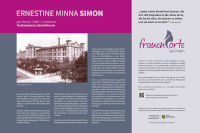
On May 28, the change to the library management system LIBERO 6 is completed.
In June, a new acquisition guideline came into force turning the University Library into a central player in the field of publications. Thus, the University Library was granted for the first time the opportunity of a comprehensive overview of all publication costs emerging at Chemnitz University of Technology.
The application of the University Library submitted to the German Research Foundation (DFG) for funding Open Access-publications in the period from 2022-2024 was approved.
Since November 1, the University counts among the members of the ORCID Germany Consortium.
Architecture Award of the Association of Architects Saxony (BDA Sachsen): The project “Reconstruction of the building ‘Alte Aktienspinnerei’ to Chemnitz University Library” was granted particular acknowledgment.
2022 German University Building Award: In March, the University Library is granted acknowledgement as “model for handling historical building structure”.
On September 22, the heads of archives, libraries, museums and collections at Chemnitz - among them also the University Library - signed an agreement for mutual assistance in emergency cases.
Since September 29, cashless payment is possible at the University Library thanks to the introduction of a simple procedure.
On October 13, the video cameras of the University Library were activated in order to further enhance security, particularly in the evening hours.
History of the „Alte Aktienspinnerei“ (“Ancient Spinning Mill”)-building
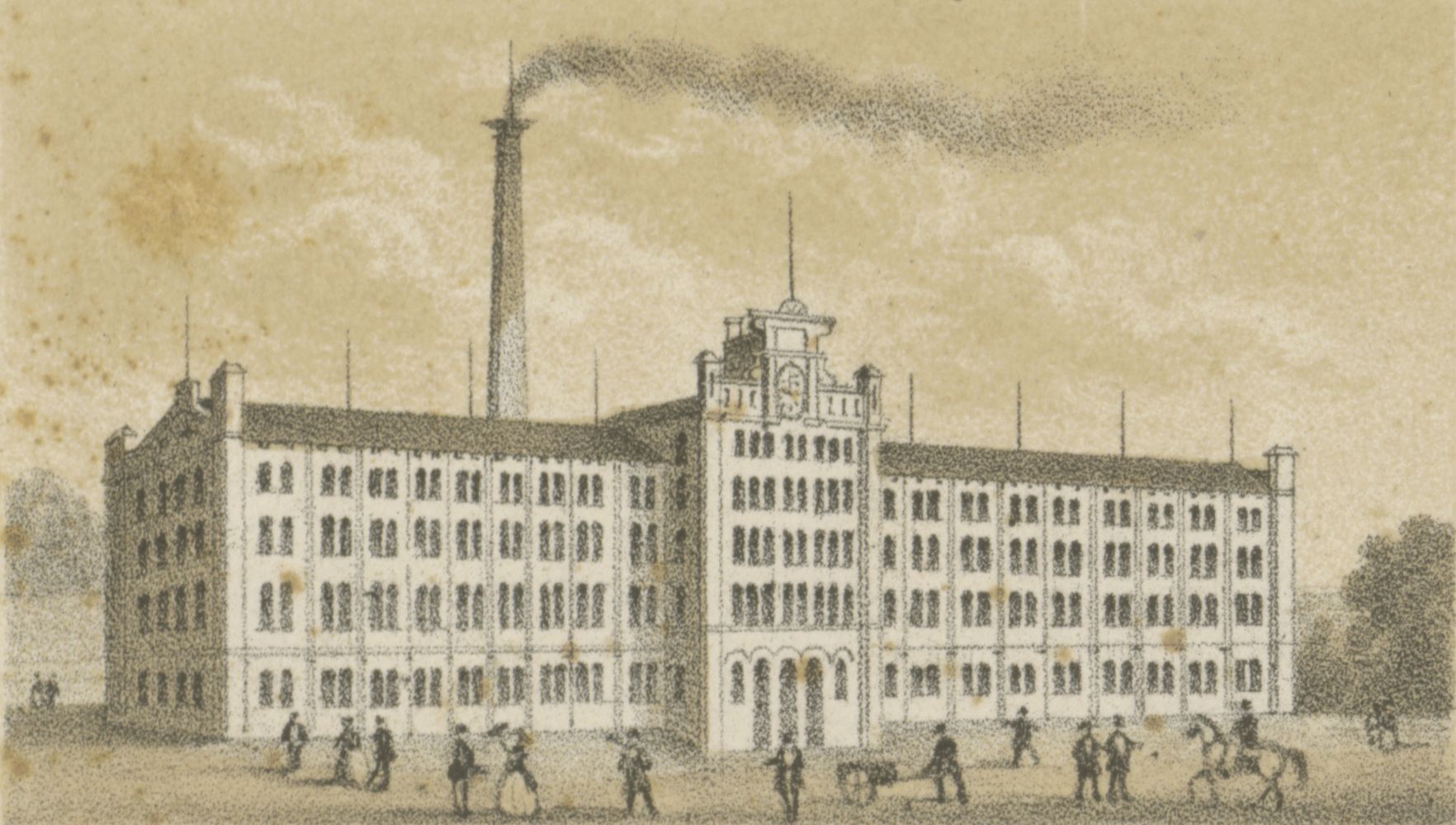
1857 - 1859 Construction of the main factory building, installation of drive technology, machines and boiler system as well as transport facilities
1861 Complementation of steam boiler system
1879 Planning and construction of a bathing facility
1882 Construction of an office and an auxiliary building as well as a garage
1884 Increase of the height of the roof of the boiler house as well as installation of two traction towers
1884 Reconstruction of the Central Building for the purpose of a new steam boiler system
1889 Construction of a cotton depot and coal storage facilities at the railway tracks
1904 - 1906 Installation of an electric lighting system for the companies C.A. Speer and N. Strauß & Co
1907 Installation of ceiling light shafts in the top level of the Central Building
1917 Construction of a tramway connection for transport of goods
1924 Construction of an additional chimney as well as a coach house
1931 Installation of a passenger and freight elevator
1943 Construction of a forced labor camp
1946 Reconstruction of the atrium severely damaged during the war
1947 Modernization by Janiks Wohn- und Gaststättengesellschaft mbH
1949 Installation of canteen kitchen facilities
1950 Installation of theater box offices of the opera house and move-in of the City Library
1951 - 1953 Installation of an HO (retail company) sales room for delicacies, expansion of the workshops of the Municipal Theatre, installation of fire prevention systems
1957 - 1958 Implementation of comprehensive construction works for the Wismut department store “Glück Auf”
1959 - 1961 Reconstruction and modernization of the Municipal Puppet Theater
1971 Annex of a café-garden in direction of Schillerplatz
1973 Installation of further training rooms at the 3rd level
1977 Installation of a neon tube system “Glück Auf”
1998 Reconstruction of the Puppet Theater to a Children’s Library
2000 Move-in of the New Saxon Gallery
2002 Installation of the dance bar “Helios” at the auxiliary building Straße der Nationen
2014 - 2020 Reconstruction to the central University Library of Chemnitz University of Technology
in the Central Building
- 1859 - 1914 Chemnitzer Actien-Spinnerei (Chemnitz Spinning Company, entire area)
- 1908 - 1945 Axminster Teppichfabrik Fritz Loewenthal (carpet company)
- 1910 - 1918 Fa. „Otto Hofmann Nachf.“ (furniture company)
- 1914 - 1923 Municipal grain warehouse
- 1920 - 1929 Fa. „Strumpffabrik Johannes Möbius“ (hosiery company)
- 1922 - 1924 Fa. „Gewerbe-Kunstdruck GmbH Müller, A.“, (commercial art printing company: pattern drawings, outfit embroidery, hand printing for woven material)
- 1922 - 1929 Fa. „Hiller, O., Tapezier- und Polstermöbelgeschäft“ (wallpaper and upholstery company)
- 1922 - 2000 Municipal Theater/ Opera House Chemnitz
- 1923 - 1927 Fa. „Erste Chemnitzer Piano-Fabrik Arthur Steudtner“ (piano company)
- 1923 - 1944 Fa. „Walter Kohler - Mechanische Schnurenklöppelei“ (pillow lace company)
- 1941 - 1944 Special police units
- 1943 - 1945 Forced labor camp
- 1945 - 1949 „Janiks Chemnitzer Wohn- und Gaststättengesellschaft“, (housing and catering company: canteen, overnight stays, café house)
- 1948 - 1959 Fa. „BUMAG“, (accounting and business machine company)
- 1948 - 1960 Health spa/ health institute Quisiana
- 1949 - 1953 Public Theater, club-, discussion- and lecture-room
- 1950 - 1993 Volkssolidarität (social welfare association)
- 1950 - 2004 Public Library
- 1950 - 1990 Department store “Glück Auf”
- 1955 - 1996 Municipal Puppet Theater
- 1973 - 1994 School for Economy Rodewisch, branch Chemnitz
- 1991 - 1999 EDEKA Aktiv-Markt (supermarket)
- 2000 - 2004 New Saxon Gallery
- 2008 - 2012 Form - Farbe - Geste (art exhibitions)
in the Auxiliary Building
- 1920 - 1929 Municipal warehouse
- 1923 - 1929 Fa. „Paul Matz, Buch- und Steindruck“ (printing and masonry company)
- 1926 - 1930 Fa. „Max Kühnrich, Spulereigeschäft“ (spool sales shop)
- 1928 - 1935 Statistical Office, branch Youth and Welfare Office
- 1936 - 1939 „Schenk und Schmidt“ (architectural office)
- 1937 - 1939 Fa. „Oertel und Türpe“ (freight and long-distance transport)
- 1938 - 1940 "Reichsluftschutzbund", branch Chemnitz (paramilitary organization in Nazi Germany founded as branch of the German Aviation Ministry)
- 1938 - 1940 "Wehrersatzinspektion, Gruppe K" (military recruiting office of the Wehrmacht, group motor vehicles)
in the Office Building
- 1905 - 1910 E.M. und J.N. Speer, Kontor (merchant)
- 1905 - 1911 Fa. „N. Strauß und Co.“ (embroidery and hosiery company)
- 1906 - 1910 Fritz Loewenthal (carpet weaving company)
- 1906 - 1915 Fa. „August Marschel & Co.“ (hosiery company)
- 1910 - 1929 Fa. „Hans Stein“ (silk and lining wholesale company)
- 1931 - 1944 Fa. „Hofmann & Kühn“ (bicycle components and accessories wholesale company)
- 1939 - 1944 "NSV-Ortsgruppe"/"Wehrersatz-Inspektion" (branch of National-Socialist Public Welfare Association/ military recruiting office of the Wehrmacht)
- 1966 - 1990 County Court Karl-Marx-Stadt
in the Domestic Facilities Building
- 1919 - 1929 Fa. „Rudolf Wittig, Nachf.“ (coal, briquet and timber trade company)
- 1922 - 1924 Fa. „Wilhelm Heinig“ (food and feed wholesale company)
- 1926 - 1932 Fa. „E.P. Grabner & Co“ (milling products company)
- 1928 - 1938 Fa. „Morgenstern, A.“ (gas, water and steam instruments company)
- 1933 - 1940 Fa. „Franz Hieck“ (furniture transport company)
- 1939 - 1944 Fa. „Härtel Hugo“ (agricultural machines company)
- 1943 - 1944 Fa. „Ernst Clemingen“ (local products company)
- 1943 - 1944 Municipal Health Authority

